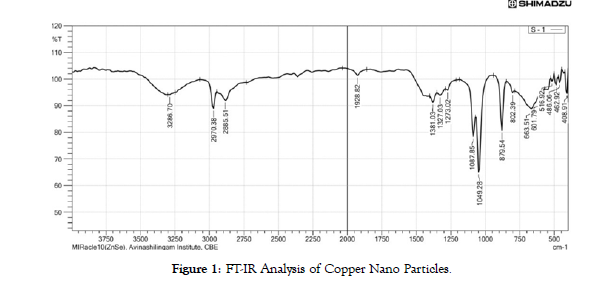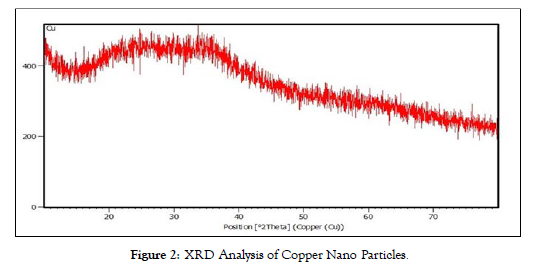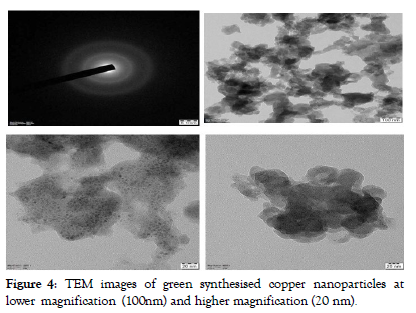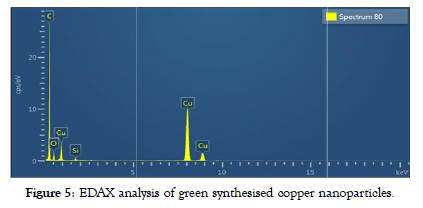PMC/PubMed Indexed Articles
Indexed In
- Open J Gate
- Genamics JournalSeek
- Academic Keys
- JournalTOCs
- ResearchBible
- China National Knowledge Infrastructure (CNKI)
- Scimago
- Ulrich's Periodicals Directory
- Electronic Journals Library
- RefSeek
- Hamdard University
- EBSCO A-Z
- OCLC- WorldCat
- SWB online catalog
- Virtual Library of Biology (vifabio)
- Publons
- MIAR
- Scientific Indexing Services (SIS)
- Euro Pub
- Google Scholar
Useful Links
Share This Page
Journal Flyer

Open Access Journals
- Agri and Aquaculture
- Biochemistry
- Bioinformatics & Systems Biology
- Business & Management
- Chemistry
- Clinical Sciences
- Engineering
- Food & Nutrition
- General Science
- Genetics & Molecular Biology
- Immunology & Microbiology
- Medical Sciences
- Neuroscience & Psychology
- Nursing & Health Care
- Pharmaceutical Sciences
Research Article - (2024) Volume 15, Issue 2
Green synthesis of Copper Nanoparticles using âHemigraphis colorataâ leaf extract and its characterization
Suprraja S*, Sorlin Selva Joice, Karthikeyan M S, Jeevanesh E and Mohamed AfsalReceived: 01-Mar-2024, Manuscript No. jnmnt-24-25186; Editor assigned: 04-Mar-2024, Pre QC No. jnmnt-24-25186(PQ); Reviewed: 18-Mar-2024, QC No. jnmnt-24-25186(QC); Revised: 25-Mar-2024, Manuscript No. jnmnt-24-25186(R); Published: 31-Mar-2024, DOI: 10.35248/2157- 7439.24.15.720
Abstract
Purpose: To synthesize the copper nanoparticles Cu-Nps ,and to find the anti microbial activity of the plant “Hemigraphis colorata”.
Aim & objective: The aim of this research work was to synthesize g-Cu NPs mediated by Hemigraphis colorata medicinal plant leaf extract. The integration of bioactive compounds of this medicinal plant with Cu NPs is believed to be extremely beneficial for varieties of ailments. The biogenically synthesized g-Cu NPs were characterized using UV-visible,FT-IR,XRD,SEM,TEM and EDAX techniques. The antimicrobial properties of g-Cu NPs have also been evaluated against gram-positive and gramnegative bacteria.
Methodology: Hemigraphis colorata (or) murikooti is a postrate herb with rooting branches, deep reddish leaves and white flowers. It belongs to the family Acanthanceae. The leaf was collected from the medicinal garden. Leaf was extracted for the synthesis of nanoparticles. The characterization of nanoparticles were noted (UV-vis, FT-IR,XRD,SEM TEM,EDAX).The microbiological activity of the leaf is noted.
Results and discussion: The green synthesis Cu NPs were synthesized by using copper sulphate as a precursor and plant leaf extract as a reducing and capping agent. The change in color from blue to light brownish visually indicates the formation of copper NPs. The Cu NPs were washed by demonized water and ethanol to remove any unwanted particles.
Keywords
Hemigraphis colorata; Green Synthesis; Cu NPs Characterization
Introduction
A nano-particles is a small particles that ranges between 1-100 nanometers in six undectectable by the human eye, nano particles can exhibit siginificantly different physical and chemical properties to their large materials counter parts. Copper nano particles is a copper based particle is 100 nm size. copper nanoparticles with great catalytic activities can be applied to biosensors and electrochemical sensors. copper is one of the nine minerals that are recognized as essentials nutrients for humans, as it plays an important role in different physiological normal processes in basically all human tissues,as well as skin. The plant Hemigraphis colorata is a versatile tropical low-creeping perennial herb [1,2]. It is a prostrate growing plant with spreading rooting stems. The leaves are opposite, ovate to cordate, bearing well–defined veins, slender and lance shaped with toothed scalloped margins. The leaf has the chemical constituents such as natrium, calcium, Carboxylic acid, cinnamate, chlorogenate, coumarate, coumarins, flavonoid polyphenol, saponin, Tannin, ferulate, gallate, ascorbic acid, E-phenol, carbohydrates, steroids, saponnins, tannins, proteins, flavonoids. Drug Delivery System is the controlled release of therapeutic agents. Drug Delivery System monitors the drug released and the location in the body where it is released [3,4]. The upcoming drug delivery systems include the researches in the areas of crossing the Blood-Brain Barrier (BBB) in the brain, diseases and disorders, Enhancing targeted intracellular delivery, combining diagnosis and treatment. Drug delivery refers to approaches, formulations, technologies, and systems for transporting a pharmaceutical compound in the body some time based on nanoparticles [5] as needed to safely achieve its desired therapeutic effect [6]. It may involve scientific site-targeting within the body, or it might involve facilitating systemic pharmacokinetics; in any case, it is typically concerned with both quantity and duration of drug presence. Drug delivery is often approached via a drug's chemical formulation, but it may also involve medical devices or drug-device combination products. Drug delivery is a concept heavily integrated with dosage form and route of administration, the latter sometimes even being considred part of the definition Nanoparticles can oocur naturally be created as the by-product of combustion reactions or be produced purposefully through engineering to perform a specialised function .Ability to generate the materials in particular way the use of nanoparticles spans a wide variety of industries from healthcare and cosmetics to enviromental preservation and air purification [7,8]. In health care field nanoparticles eg; utilises nanomaterials in a variety of ways,with one major use being drug delivery. A copper nanoparticles is a copper based particle is to 100nm sixe.A copper nanoparticles can be formed by material processes or through chemical synthesis.These nanoparticles are of particular interest due to their historcial application as colouring agent and their modren dat biomedicial ones.Copper nanoparticles are graded as highly flammable solids ,they must be stored away from the ignition [9,10].
MATERIALS AND METHODS
Materials collection: The selected plant was collected from medicinal garden pallakad and authenticated at BSI, Sothern Regional Centre its voucher no is BSI/SRC/5/23/212.The specimen was submitted for further references.
Methodology for green synthesis of copper nanoparticles: Plant leaves were collected and washed, the leaf powder was soaked 1 litre of distilled water and held in a shaker at 30 c for 48 hour for continuous stirring at 50rpm for thorough mixing. The aqueous plant extract was used to reduce CUSO4,5H2O, 100ml of plant extract was added into 90ml of 10Mm of copper sulphate solution and kept in stirring for constant mixing under 50-60 c temperature. A colour change of the solution was noted by visual examination, this confirmed the synthesis of copper nanoparticles. The characterization of nanoparticles were noted such as (UVVis, FT-IR,XRD,SEM,TEM,EDAX)The anti-microbial property of copper nano particles was determined.
Characterisation techniquines
UV-VISIBLE
An absorbance spectrum was recorded by allowing the instrument to scan wavelengths ranging between 200 and 800nm, and the absorbance of the nanoparticle solution against blank extract solution was collected.
FT-IR
Fourier transform-infrared spectroscopy (FT-IR) spectrum (FT-IR PerkinElmer) was recorded using KBr pellets in the range of 400- 4000 cm-1.
XRD
X-ray diffraction (XRD-Shimadzu X-ray diffractometer) (PXRD-7000) analytical technique was used to reveal crystalline nature of g-Cu NPs.
SEM
The scanning electron microscopy with energy-dispersive X-ray spectroscopy (SEM-EDX-EVO 18 model with low vacuum facility and ALTO 1000 Cryo attachment).
TEM
Transmission electron microscope high-resolution (JEM-2100plus HRTEM) were used for understanding morphological and structural features of g-Cu NPs.
RESULTS AND DISCUSSION
The green synthesis Cu NPs were synthesised by using copper sulphate as a precursor and plant leaf extract as a reducing and capping agent. The change in colour from blue to light brownish visually indicates the formation of copper NPs. The Cu NPs were washed by deionised waterand ethanol to remove any unwanted particles.
Characterisation of green synthesised copper nanoparticles
UV - Vis spectroscopic analysis of copper nanoparticles
UV spectroscopy within the 200-800 nm range initially verified the development of CuNPs. Acharacteristic peak of 575 nm showed the absorption spectrum of green synthesised CuNPs.
FT-IR Spectral Analysis
A Fourier transform infrared spectroscopy was utilised as an affirmative method for the construction of nanoparticles. This study offers an imprint of current molecules vibrational and rotational modes, thus helping to classify the functional and potential plant molecules involvedin copper nanoparticles reduction [Figure 1].
Figure 1: FT-IR Analysis of Copper Nano Particles.
XRD Analysis
The structure of the nanoparticles indicated by XRD analysis of the synthesised copper nanoparticles. At 2θ values of 44.32°, and 65.25° degrees, diffraction peaks observed [Figure 2].
Figure 2: XRD Analysis of Copper Nano Particles.
Morphological Analysis by SEM
FE-SEM analysis used to study the shape and size of the copper nanoparticles. The SEM study carried out using the Schottky FESEM (Japan) TESCAN MIRA3 LMH model. Microscopy of copper nanoparticles has shown that they have a nano-range particle size (500nm) which is spherical and homogeneous in distribution. Under the FE-SEM Microscope [Figure 3].
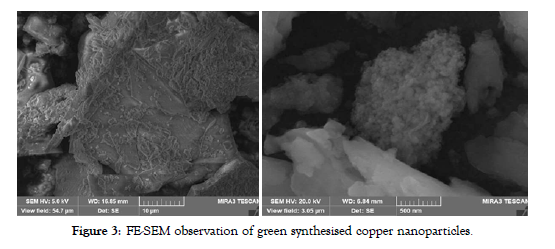
Figure 3: FE-SEM observation of green synthesised copper nanoparticles.
Morphological and Compositional Analysis by TEM and EDAX
To get the further deep insight on the morphology, size, and crystalline nature of the copper nanoparticles TEM analysis was employed. The TEM images of green synthesised copper nanoparticles (Figure 4) shows that the synthesised nanoparticles exhibited different shapes. Plant extract as capping and stabilising agents [Figure 4].
Figure 4: TEM images of green synthesised copper nanoparticles at lower magnification (100 nm) and higher magnification (20 nm).
EDAX analysis
The elemental analysis of the copper nanoparticles forms the EDAX spectrum of the FE-SEM. The EDAX spectrum is consistent with the presence of copper in the nanoparticle. The percentage of molecular mass and atomic values of Cu is 32% and 8.31 % respectively [Figure 5].
Figure 5: EDAX analysis of green synthesised copper nanoparticles.
Antimicrobial activity
Testing the susceptibility of antimicrobial agents can be done in a flexible way using the disc diffusion method. It is frequently employed in research on the antibacterial properties of plant extracts and naturally occurring antimicrobial agents.
Antibacterial Activity
Antibacterial activity is a substance's ability to kill bacteria or slow their growth. Antibacterial chemicals can kill bacteria on a local level while remaining non-toxic to surrounding tissue.
Figure 6: Antibacterial activity.
CONCLUSION
The green copper nanoparticles (g-Cu NPs) were successfully synthesized by using medicinal plant Hemigraphis colorata.The biogenically synthesized g-Cu NPs were characterized using UVvisible, FT-IR, XRD, SEM, TEM and EDAX techniques.The present research work gives comprehensive report on synthesis and antimicrobial activities of g-Cu NPs which in turn will have significant impact on biomedical applications.The UV-visible absorbance and reflectance spectra showing λmax of 575 nm. FTIR spectra supported the presence of capping agents on the surface of g-Cu NPs. The crystalline nature and composition of g-Cu NPs were confirmed by XRD pattern and EDAX spectrum, respectively. The SEM and TEM micrographs provided enough evidence towards the nano morphology of g-Cu NPs with Spherical shapeswith an average particle size of 500nm and Homogenous distribution .The antimicrobial properties of g-Cu NPs have also been evaluated against gram-positive and gram-negative bacteria.The g-Cu NPs synthesized by using the leaf extract of Hemigraphis colorata against pathogens Staphylococcus aureus, Escherichia coli showed a broad range of antibacterial activity with a zone of inhibition 11 and 15 mm respectively.The wide zone of inhibitions of g-Cu NPs against pathogens confirms their great potential as a remedy for infectious diseases caused by the tested bacterial pathogens.
REFERENCES
- Schleich N, Sibret P, Danhier P, Ucakar B, Laurent S, Muller R N, et al. Dual anticancer drug/superparamagnetic iron oxide-loaded PLGA-based nanoparticles for cancer therapy and magnetic resonance imaging. Int J Pharm. 2014;466(1-2): 172-185.
- Miller K D, Nogueira L, Mariotto A B, Rowland J H, Yabroff K R, Alfano, et al. Cancer treatment and survivorship statistics, 2019. CA Cancer J Clin. 2020; 69(5): 363-385.
- Lee S, Patel T. Tumor-Targeted Drug Delivery Utilizing Engineered T Cells. Frontiers in Immunology. 2018; 9: 2294.
- Garcia J R, Davis J. Probing Targeted Nanoparticle Surface Interactions with Cellular Membranes. ACS Nano. 2019; 13(8): 9137-9151.
- Smith A M, Lee K. Conjugated Polymer Nanoparticles for Imaging and Therapeutics. Bioconjugate Chemistry. 2022; 33(1): 1-13.
- Brown M, Anderson R, Artis D. Intestinal Memory CD4+ T Cells Function to Suppress Inflammation in the Gut. Journal of Immunology. 2018; 187: 16-187.
- Anderson J C, White K A. Structure of the African swine fever virus major capsid protein p72. Cell Reports. 2021; 36(7): 109454.
- Parker N, Smith A. Multiple Myeloma Antibodies and Targeted Therapies. Hematol Oncol Clin North Am. 2019; 33(1): 37-55.
- Johnson D E, O'Keefe R A, Grandis J R. Targeting the IL-6/JAK/STAT3 signalling axis in cancer. Nat Rev Clin Oncol. 2022;19(3): 208-222.
- Smith A M, Davis J. Increasing the accuracy of nanoparticle sensing using a multi-level gating approach. Nature Communications. 2019; 10(1): 1-9.
Indexed at, Google Scholar, Crossref
Indexed at, Google Scholar, Crossref
Indexed at, Google Scholar, Crossref
Indexed at, Google Scholar, Crossref
Indexed at, Google Scholar, Crossref
Citation: Suprraja S (2024) Green Synthesis of Copper Nanoparticles using â??Hemigraphis Colorataâ? Leaf Extract and its Characterization. J Nanomed Nanotech. 15: 720.
Copyright: ©2024 Suprraja S. This is an open-access article distributed under the terms of the Creative Commons Attribution License, which permits unrestricted use, distribution, and reproduction in any medium, provided the original author and source are credited.



